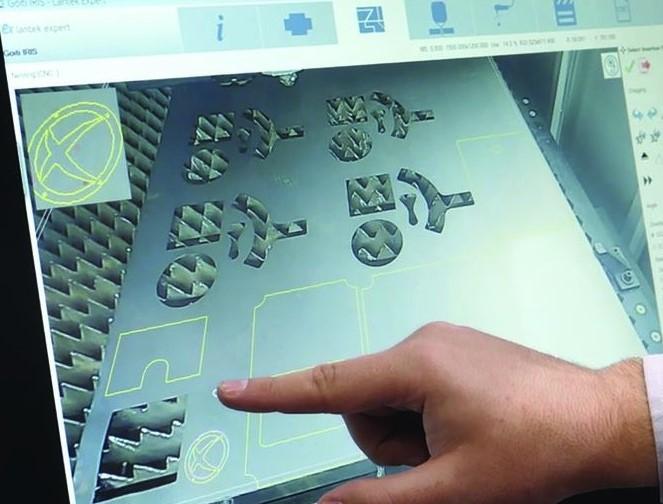Marketing Manager
- FMA
- The Fabricator
- FABTECH
- Canadian Metalworking
Categories
- Additive Manufacturing
- Aluminum Welding
- Arc Welding
- Assembly and Joining
- Automation and Robotics
- Bending and Forming
- Consumables
- Cutting and Weld Prep
- Electric Vehicles
- En Español
- Finishing
- Hydroforming
- Laser Cutting
- Laser Welding
- Machining
- Manufacturing Software
- Materials Handling
- Metals/Materials
- Oxyfuel Cutting
- Plasma Cutting
- Power Tools
- Punching and Other Holemaking
- Roll Forming
- Safety
- Sawing
- Shearing
- Shop Management
- Testing and Measuring
- Tube and Pipe Fabrication
- Tube and Pipe Production
- Waterjet Cutting
Industry Directory
Webcasts
Podcasts
FAB 40
Advertise
Subscribe
Account Login
Search
How remote work affects metal fabrication shops
The COVID-19 era has forced many manufacturing office workers to operate remotely
- By Kevin Must
- November 6, 2020
- Article
- Manufacturing Software

These days, many working for the business office of metal fabrication shops are doing so remotely. How are those office workers handling the transition in the COVID-19 era? Getty Images
Just 12 months ago the national and global manufacturing economies were booming. Personal protective equipment (PPE) on the shop floor entailed safety glasses, earplugs, welding helmets, and gloves—usually not face masks and shields. Factories were working three shifts with 100% staff and orders were stacking up. On any given day there were likely a handful of face-to-face meetings, paper traveler handoffs on the shop floor, and other personal interactions to keep production moving efficiently. This was daily life at the shop—until it wasn’t.
COVID-19 wreaked havoc on a global scale, shuttering economies to combat the spread. As states shut down, manufacturers adapted their work flow and maybe even their entire operation to continue producing. To keep physically distant, those who could work at home did.
How did fabricators handle the transition? In all likelihood, that depended on shop communication practices and, not least, the manufacturing monitoring and communication technology it used. In this pandemic age, connectivity has stepped to the fore.
Two Shops, Different Connectivity
Imagine two hypothetical custom metal fabricators, both job shops of equal capacity, revenue, staff, and throughput, but with one critical difference: how they communicate, document, and access information.
We’ll call the first shop the semiconnected manufacturer. The company has CAD/CAM and CNC machines, of course, and the usual office programs like Excel. It uses Excel for quoting and has static production boards on the shop floor for scheduling. Managers hold daily meetings to discuss production status, the schedule for the day, and any other necessary business. Operators on the floor work off paper travelers and have standup meetings with necessary operations up- or downstream.
The second shop is the connected manufacturer. The company uses CAD/CAM, a manufacturing execution system (MES), and enterprise resource planning (ERP) to program, schedule, and manage manufacturing and business operations. Its machines are internet-enabled, allowing work instructions and programs to be sent directly to the control. Operations that may be offline can be tracked using tablets, bar code scanners, and other technologies.
Work instructions are sent downstream to operators on their control or workstation tablet. With permission-based access to the company database, employees make decisions not on assumptions but on real-time data from the shop floor.
Let’s say that both facilities must process 100 laser-cut 4- by 2-in. blanks from 16-ga. mild steel. The customer would like each piece bent to 90 degrees and welded together to create an open box, creating 50 total boxes. Lastly, the customer wants the boxes powder-coated and shipped within five days. Both facilities can process the entire job in-house. Before the shutdown, how would each handle this order, from request for quote (RFQ) to completion?
RFQ to Production, Pre-lockdown
The Semiconnected Manufacturer. The prospect, who probably heard of this shop from a friend or perhaps a quick online search, calls the sales department and has a pleasant conversation in which the staff collects information such as company contact, quantity, material type, basic dimensions, operations needed, and desired delivery date. With this information, the salesperson sends a follow-up email to request a part file from the customer for a more accurate quote. The customer is busy and takes a day to return the email with the necessary part file.
With the file finally in hand, the salesperson forwards it to the manufacturing staff to have a programmer run a nest of the parts and calculate time and cost of each downstream operation. With this information, the sales team then must talk with the production manager to see what the shop’s current schedule looks like and what capacity may be available. Before committing to the customer’s desired due date, sales checks the production board and walks to the floor to ensure what is on the schedule is on time.

CNC CAD/CAM nesting allows operators to receive work instructions remotely as well as modify nestings on-the-fly with a built-in camera.
After everything is said and done, the salesperson returns a quote to the customer at the end of the second day but does not receive an acceptance and purchase order until the third morning. Now, with two days left until ship date, the shop must confirm the schedule, prepare the final programs, switch any tooling, and put this part into production.
Only a short turnaround time remains once the final quote is accepted. This leads to more unexpected costs if production runs over a third shift or into overtime—costs that, of course, the customer isn’t about to pay for.
With the part in production, the customer, curious about the status, calls the salesperson, who now must make another call to the production manager, who walks to the shop floor and communicates with various operators for a status update before notifying the salesperson and, ultimately, the customer.
The Connected Manufacturer.The customer discovers this shop online through a robust website showing their capabilities and even an online RFQ form. The customer submits their RFQ with all necessary information: contact, material type, quantity, operations, delivery date, and an uploaded DXF file. Once that information is submitted, the customer receives an automated email thanking them for their request and ensuring them they will be contacted shortly. At the same time, sales and production staffs are notified of the request with all the information and part files needed to begin quoting.
Using connected machines and systems, the salesperson begins generating a quote while the system runs nests, assigns operations, and checks upcoming schedules against capacity to generate a cost and completion date. Before the salesperson can release the quote, the production manager is notified to verify the job can be produced. This happens within minutes, with the quote being sent to the customer within hours, if not less. The customer reviews and accepts the quote on the same day, giving the manufacturer four full days of production.
With the part in production, the customer is curious about its status and calls their salesperson. With machines and operations connected via shop floor monitoring, the salesperson pulls up the order and sees exactly where it is in production.
The Shutdown Commences
Reported cases of COVID-19 began to swell in the spring, and the lockdowns commenced. In the U.S., nonessential businesses were asked to close to contain the spread. Manufacturers that didn’t traditionally supply essential industries scrambled to find ways to keep their doors open and employees working. Those that could remain open had to find new ways of working while practicing social distancing and other health precautions laid out by the CDC. Using PPE wasn’t a new concept for shop floor operators. That said, the business office would experience the most change.
To stay compliant, many companies had to ensure that proper systems were employed to keep business operating as normally as possible. This meant moving management, sales, support, and engineering teams off-site. The crisis forced everyone everywhere to adapt work flows to a remote workforce. This left everyone with a host of questions as they adapted to the new normal.
How will we quote jobs with remote sales, management, and engineering staff?
At the semiconnected manufacturer, quoting jobs is difficult, especially with disparate systems. Everyone still quotes via email, Excel worksheets, and verbal communication over the phone or via teleconferencing apps. Disconnected systems in quoting and planning foster interdepartmental miscommunication between departments that can be seriously detrimental. Jobs might be accepted at a loss or when it’s impossible to meet the promised delivery date. With some working remotely and others at the shop, everyone places a lot of calls and sends a lot of email just to receive status updates.
At the connected manufacturer, quoting doesn’t see much change. All necessary parties can access pertinent information according to their role. The system consults company data and generates accurate production time calculations, prices, and delivery dates. It records when each task is complete and assigns the next task to the subsequent person in the work flow.
How will we know about upcoming orders and in-process quotes so we can plan and staff properly?
The semiconnected manufacturer still relies on the weekly or daily production meetings, which are now virtual. It’s introduced a project management app for certain staff to use internally so they can track quotes, tasks, and production while shopping for a more permanent solution. These methods create a disconnected and cumbersome tracking method too reliant on the human factor. Asking staff to learn new systems during turbulent times, especially when working remotely, poses greater risk of improper implementation and requires a great deal of time-consuming interdepartmental communication. This makes it difficult for management to analyze operations, understand which areas are strained more than others, and how to properly staff.
Employees at the connected manufacturer, on the other hand, were able to pack up and work remotely without difficulty. They weren’t working with new platforms, nor did they require training. They just had their platforms installed on their laptops or home PC. And because they relied heavily on web-based tools, they could access needed information from any internet-enabled device.
Employees quickly see orders pending production, orders pending scheduling, quotes pending acceptance, and requirements for each order according to their system permissions. This cuts down on interdepartmental communication and allows management to better understand what areas need staff and other resources.
How will engineering program jobs and send work instructions to operators?
Once the quote is accepted at the semiconnected manufacturer, the engineering department finalizes the job programming and routing and sends it to operations. To reduce face-to-face contact, engineers create a work flow to eliminate paper travelers. They now use laptops and tablets at each workstation to communicate via an internal company chat app. As laser operators finish cutting, they notify the next person downstream and the engineer, at which time they send the next operations instructions.
Still, no one can view statuses of all jobs in real time. Instead, when the customer calls to request a status update, the salesperson still needs to consult production for an answer. Without methods to store and analyze this data, quoting still requires just as many touchpoints as before.
The connected manufacturer has connected machines and, hence, doesn’t notice many, if any, changes to the work flow. The engineer still generates the programs from wherever he or she is (maybe the living room couch) and routes them to the proper workstations. As each process is complete, the operators still validate their jobs using bar code scanners, entering data into tablets, or having the machine control report its status back to the company’s MES.
Stakeholders access pertinent information at any time. Furthermore, the system continually stores data and builds an ever-larger sample set, making quoting more accurate while offering ways to run what-if scenarios.
How will we know the status of a job in production?
Now using workstation laptops or tablets and a project management application, the semiconnected manufacturer begins to gain insights into the status of production. Again, this is a step in the right direction, but it still requires sales staff to request information from production regarding status updates. In an effort to avoid information overload, the system is set up so that only certain stakeholders in the process can access information. Unfortunately, this creates silos between departments as production may not want sales to have full access to their information.
Conversely, the connected manufacturer uses various production tracking methods, and its staff is already set up with the proper systems to track production. In fact, this shop has begun working on a robust online customer portal so they can see, in real time, that a part just left the laser and is heading to bending. In today’s “need-to-know-instantly” world, the customer portal proves to be hugely popular. The shop adds various aspects to the portal so that customers send words of encouragement to operators, boosting morale. This ultimately leads to data-based bonuses and wage increases, since everything is digitally recorded and connected.
The Value of Connection
In today’s advanced manufacturing facilities you will find internet-enabled machines, tablets for production tracking, robotic part picking systems, and other connected workcells. All these systems can be programmed and monitored from remote locations.
While productivity and output increase, connectivity allows sales teams to quote quickly and accurately. Most important, connectivity allows manufacturers to store and analyze up-to-date production data to make the most informed decisions about their business. In these tumultuous times, when information changes so quickly, decisions buttressed by current data have never been more valuable.
About the Author

Kevin Must
5412 Courseview Drive Suite 205
Mason, OH 45040
(877)-805-1028
Related Companies
subscribe now

The Fabricator is North America's leading magazine for the metal forming and fabricating industry. The magazine delivers the news, technical articles, and case histories that enable fabricators to do their jobs more efficiently. The Fabricator has served the industry since 1970.
start your free subscription- Stay connected from anywhere

Easily access valuable industry resources now with full access to the digital edition of The Fabricator.

Easily access valuable industry resources now with full access to the digital edition of The Welder.

Easily access valuable industry resources now with full access to the digital edition of The Tube and Pipe Journal.
- Podcasting
- Podcast:
- The Fabricator Podcast
- Published:
- 04/16/2024
- Running Time:
- 63:29
In this episode of The Fabricator Podcast, Caleb Chamberlain, co-founder and CEO of OSH Cut, discusses his company’s...
- Trending Articles
AI, machine learning, and the future of metal fabrication

Employee ownership: The best way to ensure engagement

Steel industry reacts to Nucor’s new weekly published HRC price

Dynamic Metal blossoms with each passing year

Metal fabrication management: A guide for new supervisors

- Industry Events
16th Annual Safety Conference
- April 30 - May 1, 2024
- Elgin,
Pipe and Tube Conference
- May 21 - 22, 2024
- Omaha, NE
World-Class Roll Forming Workshop
- June 5 - 6, 2024
- Louisville, KY
Advanced Laser Application Workshop
- June 25 - 27, 2024
- Novi, MI



























